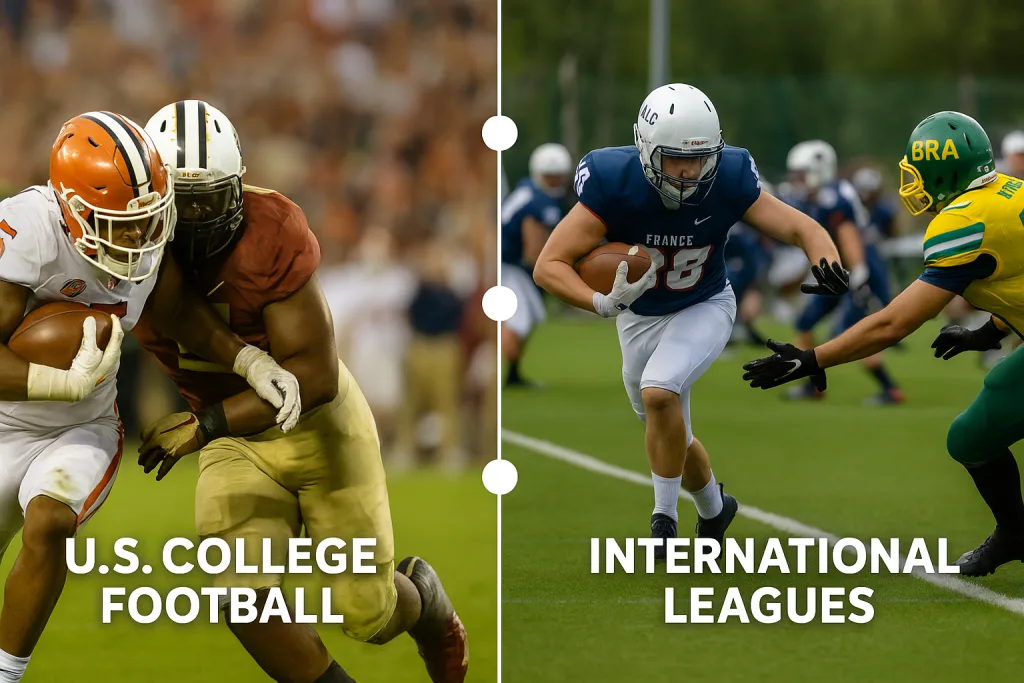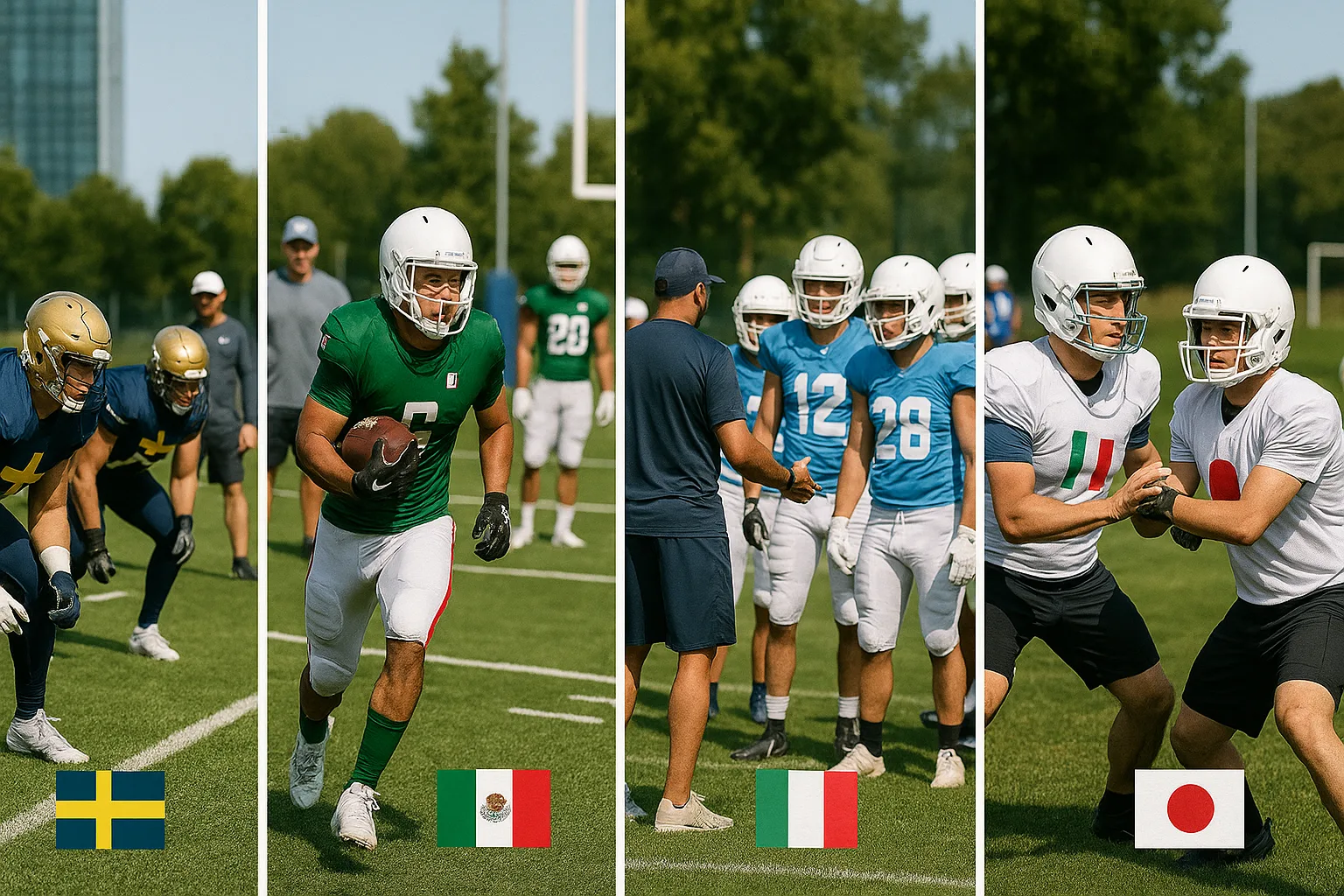American football, once perceived as a strictly American pastime, is now making waves far beyond U.S. borders. With over 90 member nations under the International Federation of American Football (IFAF) and the recent launch of the World American Football League (WAFL), the sport is clearly on a path toward global expansion. Whether it is international youth leagues, elite tournaments, or Olympic ambitions, American football is evolving into a truly international sport. In fact, participation in international American football competitions has grown by over 300% in the last decade, and more than 25 million people outside the U.S. now watch or play the sport in some form. This article explores the rapid international growth of American football, driven by organizations like the International Federation of American Football (IFAF) and the emerging World American Football League (WAFL). It examines how global governing bodies, youth development programs, professional leagues, and Olympic ambitions are transforming the sport from an American tradition into a global phenomenon.
The Global Growth of American Football
The past two decades have seen a steady and impressive global growth of American football. From local clubs sprouting up in Europe, Asia, and Africa, to large-scale international events drawing thousands of fans, the sport is capturing the attention of new audiences worldwide.
Countries like Japan, Germany, Mexico, Brazil, and France have developed robust national leagues and youth systems. Meanwhile, television and streaming platforms have made NFL games more accessible globally, sparking new interest and grassroots development in diverse regions. In countries such as Egypt, Nigeria, and India, American football clubs and national teams have emerged thanks to community investment and local government support.
A significant driver of growth has also been cross-border partnerships. NFL teams have formed international collaborations through the league’s Global Markets Program, allowing franchises to engage fans in countries like the UK, Mexico, and Germany. This has helped establish local fanbases, merchandise sales, and youth training camps.
Why American Football Is Gaining Global Traction
Several factors are driving the popularity of American football worldwide:
- Media Exposure: Global streaming and NFL International Series games have introduced millions to the sport.
- Youth Programs: Countries have launched youth and school programs modeled after U.S. high school football.
- Cultural Exchange: American military bases, expatriate communities, and cultural exports (like movies) have all helped disseminate the sport.
- Athletic Appeal: Football offers a new avenue for athletes in countries traditionally focused on soccer or rugby.
- Flag Football Accessibility: The rise of flag football has lowered barriers to entry, making it easier for schools and communities to adopt the sport.
- Diverse Career Opportunities: With new professional leagues, players can aspire to careers beyond the NFL.
Youth Development Programs around the World
The backbone of global football expansion is its youth development infrastructure. Organizations under IFAF’s guidance have created national school-based programs, training camps, and scholarship opportunities.
- Japan: Home to the oldest American football university league outside the U.S.
- Germany: Features a comprehensive club-based system for players as young as 10.
- Mexico: Hosts numerous intercollegiate competitions and has a deeply rooted high school football culture.
- Brazil: Offers under-17 and under-19 leagues with support from former players and coaches.
These efforts ensure a sustainable talent pipeline and foster early interest in the sport. They also encourage cross-border training partnerships, where coaches and players from the U.S. conduct clinics and workshops abroad.
IFAF — The International Federation of American Football
The International Federation of American Football (IFAF) is the primary governing body responsible for regulating and promoting international American football. Founded in 1998, IFAF now includes over 90 national federations across five continents.
Even International Federations have their benefits and drawbacks; here is a quick breakdown of pros and cons of IFAF:
| Pros | Cons |
| Unified governance structure; | Limited funding in smaller member nations; |
| Promotes global competition and standards; | Occasional disputes over tournament hosting rights; |
| Invests in youth and women’s programs; | Less media attention than domestic leagues; |
| Encourages Olympic recognition efforts; | Political tensions among national federations; |
| Offers educational and training certifications. | Resource disparities among federations. |
IFAF’s Role in Governing the Sport
IFAF is crucial to organizing, standardizing, and expanding the sport internationally. Here is what IFAF does:
- Rules & Regulations: IFAF maintains the official rulebook used in international competitions.
- Event Management: Oversees tournaments such as the IFAF World Championship and continental qualifiers.
- Youth Development: Supports under-19 and under-17 leagues and provides coaching resources.
- Gender Equality: Promotes the growth of women’s American football teams worldwide.
- Membership Support: Helps new and existing federations build sustainable national programs.
- Training and Certification: Offers certification pathways for coaches, referees, and team managers.
The IFAF World Championship: Building the Global Stage
The IFAF World Championship, also known as the IFAF World Cup, is the premier international tournament for national teams in American football. Held every four years, the championship brings together the best teams from across the globe.
The 2025 IFAF World Championship is expected to be the largest yet, with 16 national teams competing for the title. It serves as a showcase for rising talent and provides smaller football nations with invaluable experience and exposure.
In previous editions, teams like Austria and Japan have given powerhouse nations like the U.S. a run for their money, proving that the talent gap is closing. The 2025 edition will include live broadcasts in over 40 countries and is projected to reach an audience of more than 50 million.
The Rise of the World American Football League
While IFAF governs the amateur and national team circuits, a new entity is emerging to reshape the professional landscape: the World American Football League (WAFL). Designed to function as a global football league, WAFL is creating professional opportunities for players across continents.
Purpose and Structure of the League
The WAFL aims to:
- Establish professional clubs in major global cities.
- Create a competitive season that mirrors the NFL calendar.
- Recruit international talent from both established and emerging football markets.
- Provide high-level exposure for players, coaches, and officials.
Key Features:
- 12 founding teams across North America, Europe, South America, and Asia.
- A draft system open to players worldwide.
- Salaried players with health benefits.
- Media rights deals focused on global audiences.
- Community outreach and local partnerships to grow fanbases.
How It Differs from IFAF Tournaments
While both the WAFL and IFAF aim to grow American football globally, their models differ significantly. IFAF tournaments focus on national teams, amateur participation, and the promotion of the sport through grassroots and developmental initiatives. In contrast, the World American Football League operates as a professional, club-based league with salaried athletes, aiming to build a commercially viable and entertainment-driven global product. WAFL emphasizes annual league play and international fan engagement, whereas IFAF prioritizes structured competitions and Olympic aspirations.

Here is a detailed comparison WAFL and IFAF Tournaments:
| Feature | IFAF Tournaments | WAFL |
| Scope | National teams | Club teams |
| Frequency | Every 2-4 years | Annual seasons |
| Player Compensation | Amateur/Volunteer | Professional (salaried) |
| Purpose | Promote global representation | Build a commercial league |
| Development Focus | Youth and amateur programs | Elite, professional-level competition |
| Governance | International non-profit federation | Privately owned and funded |
American Football’s Olympic Ambitions and Long-Term Vision
One of IFAF’s major long-term goals is the inclusion of American football in the Olympic Games. While traditional 11-man tackle football is unlikely to make the cut due to logistical and safety concerns, a more compact version is gaining traction: flag football.
In 2023, the International Olympic Committee (IOC) approved flag football for inclusion in the 2028 Los Angeles Olympic Games, marking a huge milestone for the sport’s global credibility.
IFAF’s 2025–2030 Roadmap for Growth
The IFAF’s strategic roadmap includes:
- Increasing global participation to 150 national federations.
- Investing in flag football as an Olympic and youth-friendly format.
- Creating coaching and referee certification programs in underrepresented regions.
- Expanding digital access to training resources and rulebooks.
- Fostering international club competitions to bridge gaps between national and pro levels.
- Collaborating with global media platforms to increase sport visibility.
Final Thoughts
American football is no longer just “America’s game.” Through the collaborative efforts of IFAF, the ambitious expansion of the World American Football League, and the growing appetite for the sport worldwide, it is evolving into a global phenomenon. As we move toward 2030, the gridiron may become just as familiar in Tokyo, Paris, Rio, and Nairobi as it is in Texas or Ohio.
With structured governance, increased media visibility, and professional pathways, international American football is not only surviving but thriving.
FAQ
What is the World American Football League?
The WAFL is a newly formed international professional football league featuring club teams from around the globe. It aims to complement IFAF’s amateur framework with a professional, revenue-generating platform for players.
What countries dominate international American football?
Countries with established programs and past tournament success include the United States, Japan, Mexico, Canada, Germany, France, and Austria.
Which countries have been the most successful in IFAF World Championship history?
The United States has been the most successful team in IFAF World Championship history, winning multiple gold medals since joining the tournament in 2007. Other strong contenders include Japan and Canada, which consistently rank among the top teams.
Are there international women’s American football teams?
Yes. IFAF hosts Women’s World Championships, and countries like Finland, Canada, USA, and Great Britain have competitive women’s national teams.
How can players or federations join the IFAF?
National federations must apply through IFAF’s official website, demonstrating governance, league activity, and adherence to IFAF rules. Players can participate via national team tryouts or IFAF-sanctioned leagues.


